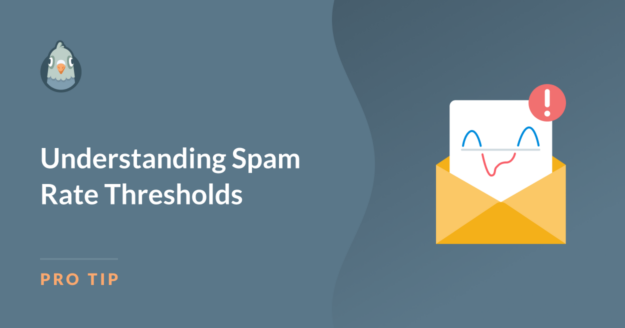AI Summary
One of the most common problems we hear from WP Mail SMTP users is that their emails are sending correctly but aren’t reaching the recipient’s inbox.
What’s going on here? While WP Mail SMTP is an excellent way to improve email deliverability, it’s not a guarantee. If you’ve received too many spam complaints or your sender reputation is poor, there’s a good chance your emails might not be delivered properly.
Email service providers set limits on every sender’s spam rate. Even if you’re not sending actual spam, if too many people click “spam” on your emails, it can cause problems. When you hit spam rate thresholds, your emails might not get delivered or could end up in junk folders.
In this article, I’ll go into detail about what exactly a spam rate threshold is, how it’s determined, give you specific spam limits for popular email providers, and tips to help you stay under those limits.
In This Article
- What Is a Spam Rate Threshold?
- Typical Spam Rate Thresholds
- Popular Email Provider Spam Rate Thresholds
- Why Do Spam Rate Thresholds Matter?
- Why Keeping Spam Complaints Low is Key – Even for Reputable Senders
- What Happens When You Exceed Spam Rate Thresholds
- How to Stay Below Spam Rate Thresholds
- What to Do If You Exceed Spam Rate Thresholds
What Is a Spam Rate Threshold?
Let’s start with the basics. The spam rate threshold is the maximum spam rate that an email service provider (ESP) will accept before it rejects your emails or marks them as spam.
Your spam rate is calculated as the number of spam complaints divided by the total number of emails delivered, expressed as a percentage. For example, a 0.1% spam rate means that for every 1,000 emails delivered, 1 recipient marked it as spam.

Each email provider calculates your spam rate based on how many of its users marked your emails as spam. So you could end up with a spam rate of 0.1% at Google and 0.3% at Yahoo, depending on how many users using those services marked your emails as spam.
While you should always aim to keep your spam rate as low as possible, it’s crucial to avoid hitting that all-important spam rate threshold. If you do, your emails may not reach the inbox even if you reduce your spam complaint rate in the future.
Typical Spam Rate Thresholds
Understanding spam rate thresholds is key to keeping your emails out of the spam folder. These numbers can be different depending on the service provider of the person you’re emailing
The email marketing industry has generally accepted certain spam rate thresholds as benchmarks. Let’s take a closer look at these thresholds to help you set good goals for your email campaigns:
- 0.1% (1 complaint per 1,000 emails): This is widely considered the gold standard. Staying below this threshold is ideal for maintaining excellent email deliverability across most ESPs.
- 0.1% – 0.3% (1-3 complaints per 1,000 emails): While not optimal, this range is usually an acceptable spam rate for your emails to be delivered normally. However, if your spam rate stays in this range, it could lead to deliverability issues over time.
- Above 0.3% (more than 3 complaints per 1,000 emails): This is typically considered to be an excessive level of spam complaints. If your spam rate goes above this level regularly, you’re likely to experience significant deliverability issues and potential blocks from email providers.
In general, you should aim to keep your spam complaint rate below 0.1% for optimal deliverability and always below 0.3%.
Popular Email Provider Spam Rate Thresholds
While the industry standards provide a good baseline, it’s important to note that different providers may have their own specific thresholds. Not every email provider publishes their spam rate thresholds but it’s a good idea to be aware of the guidelines issued by Gmail and Yahoo and others that publish sender requirements.
| Email Provider | Preferred Spam Rate | Tolerance Limit | Additional Notes |
|---|---|---|---|
| Google (Gmail) | Below 0.1% | Above 0.3% | Guidelines apply to bulk senders. Rates above 0.3% can cause problems with email delivery and affect how your emails appear in the inbox. |
| Yahoo | Below 0.1% | Above 0.3% | High spam rates harm sender reputation and email deliverability. |
| Apple Mail | Below 0.1% | Not publicly detailed | Maintaining a low spam rate is crucial for good deliverability. |
| AOL | Not disclosed | Not disclosed | AOL enforces anti-spam policies without disclosing thresholds. |
| Outlook (Outlook.com, Hotmail.com, MSN.com, Live.com) | Not specified | Configurable by admins | Outlook uses Exchange Online Protection (EOP) to filter spam. Admins can set thresholds for bulk emails. |
These thresholds and guidelines are subject to change, so it’s essential to stay updated with each email service provider’s latest policies. You can see Google’s latest sender guidelines here.
Why Do Spam Rate Thresholds Matter?
Now you know what spam rate thresholds are, let’s talk a bit more about why they should be on your radar.
This isn’t just some arbitrary number. And it’s not a clear case that your emails will be delivered if they’re under the threshold or go to spam if they’re not. There’s a lot more to consider which makes it incredibly important to avoid a high spam complaint rate.
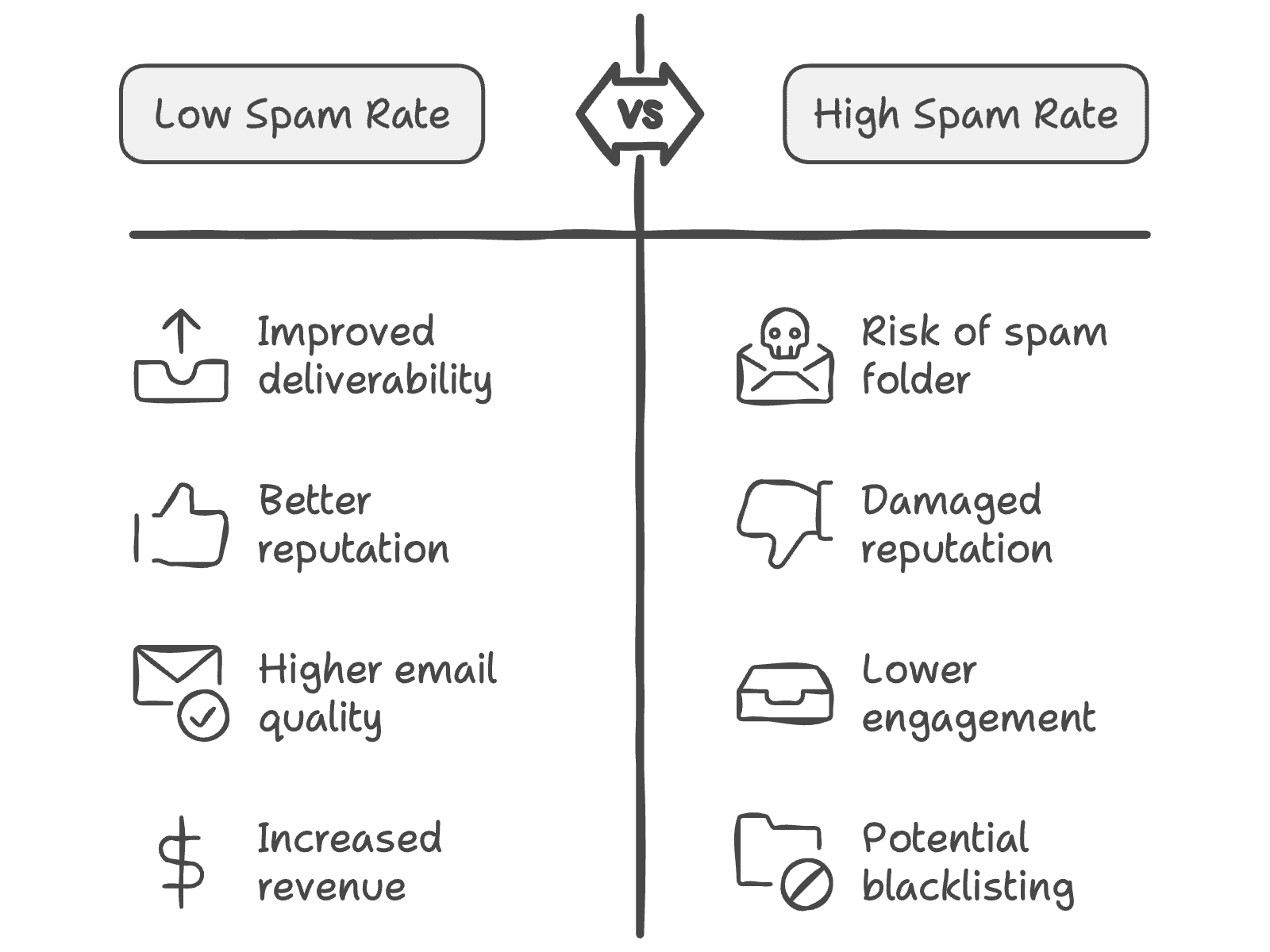
Deliverability is King
The most obvious reason spam rate thresholds matter is email deliverability. If you consistently exceed the threshold, your emails are more likely to end up in the spam folder instead of the inbox. And let’s face it, an email in the spam folder isn’t much good to anyone.
Reputation is Everything
In the email world, your reputation is everything. Exceed spam rate thresholds regularly, and you’re essentially telling ESPs that you’re not to be trusted. This can lead to more stringent filtering of your emails, lower open rates, and in severe cases, your IP address or domain being blacklisted.
It’s a Sign of Quality
Low spam rates aren’t just about avoiding penalties; they’re a sign that you’re doing email marketing right. It means your content is relevant, your list is clean, and your subscribers actually want to hear from you. Pat yourself on the back if you’re consistently below the threshold!
It Affects Your Bottom Line
At the end of the day, email marketing is about driving engagement and conversions. High spam rates mean fewer eyes on your emails, which translates to fewer clicks, less traffic, and ultimately, lower revenue. Keeping an eye on your spam rate thresholds is essentially protecting your bottom line.
Why Keeping Spam Complaints Low is Key – Even for Reputable Senders
ESPs use several factors to decide whether or not to deliver your email. These include:
- Sending Volume: Higher volume senders may be given slightly more leeway, but are also scrutinized more closely.
- Sender Reputation: A strong sender reputation might provide some buffer if you occasionally exceed thresholds.
- Engagement Metrics: High open and click rates can sometimes offset slightly higher spam complaint rates.
- Email Authentication: Properly authenticated emails (using SPF, DKIM, and DMARC) are more likely to be delivered.
However, don’t make the mistake of thinking you can get away with exceeding spam rate thresholds as long as you follow best practices most of the time.
A high number of spam complaints can quickly damage your sender reputation and lead to deliverability issues, even if you have previously maintained a good reputation.
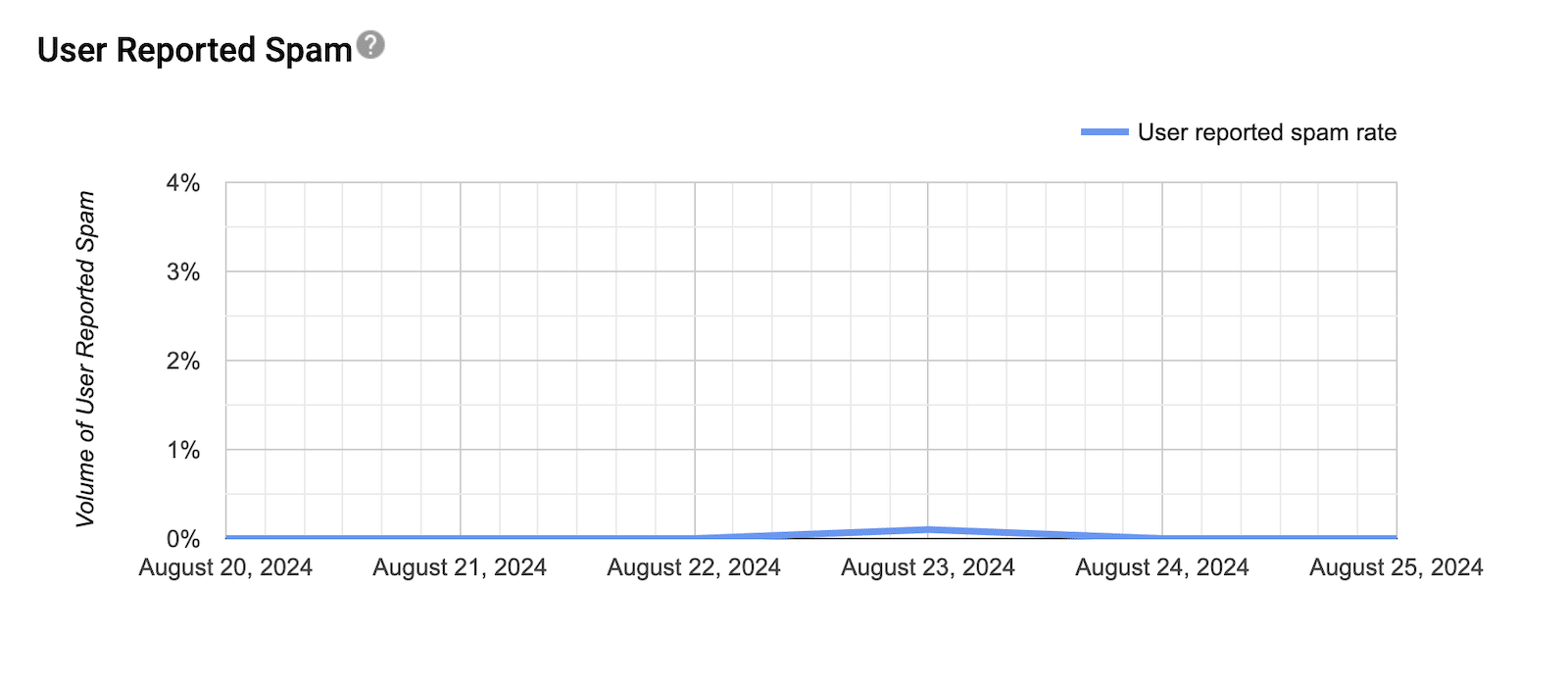
Google Postmaster Tools is one tool you can use to monitor your user reported spam rate over time. It will also alert you if you hit those critical spam complaint rate thresholds.
What Happens When You Exceed Spam Rate Thresholds
Regularly going over spam rate thresholds can cause significant problems. It can hurt how well your emails perform, how people see your brand, and even your business’s success. Let’s look at why this matters so much.
Reduced Deliverability
The first thing you may notice if you go over the spam rate limit is that your emails might end up in the spam folder instead of the inbox. This means your carefully crafted messages won’t reach their intended audience.
In some cases, your emails might not even make it to the spam folder – they could be blocked entirely.
Email service providers might also decide to slow down the delivery of your emails. This can cause issues with the timing of your campaigns, especially if you’re announcing time-sensitive information like sales or events.
You might also notice that some of your emails get through fine, while others don’t. This inconsistency can make it difficult to predict how your campaigns will perform.
Damage to Sender Reputation
ESPs use reputation scores to evaluate the trustworthiness of senders. These scores are assigned to your IP address and sender domain, and they’re partly based on how often people mark your emails as spam.
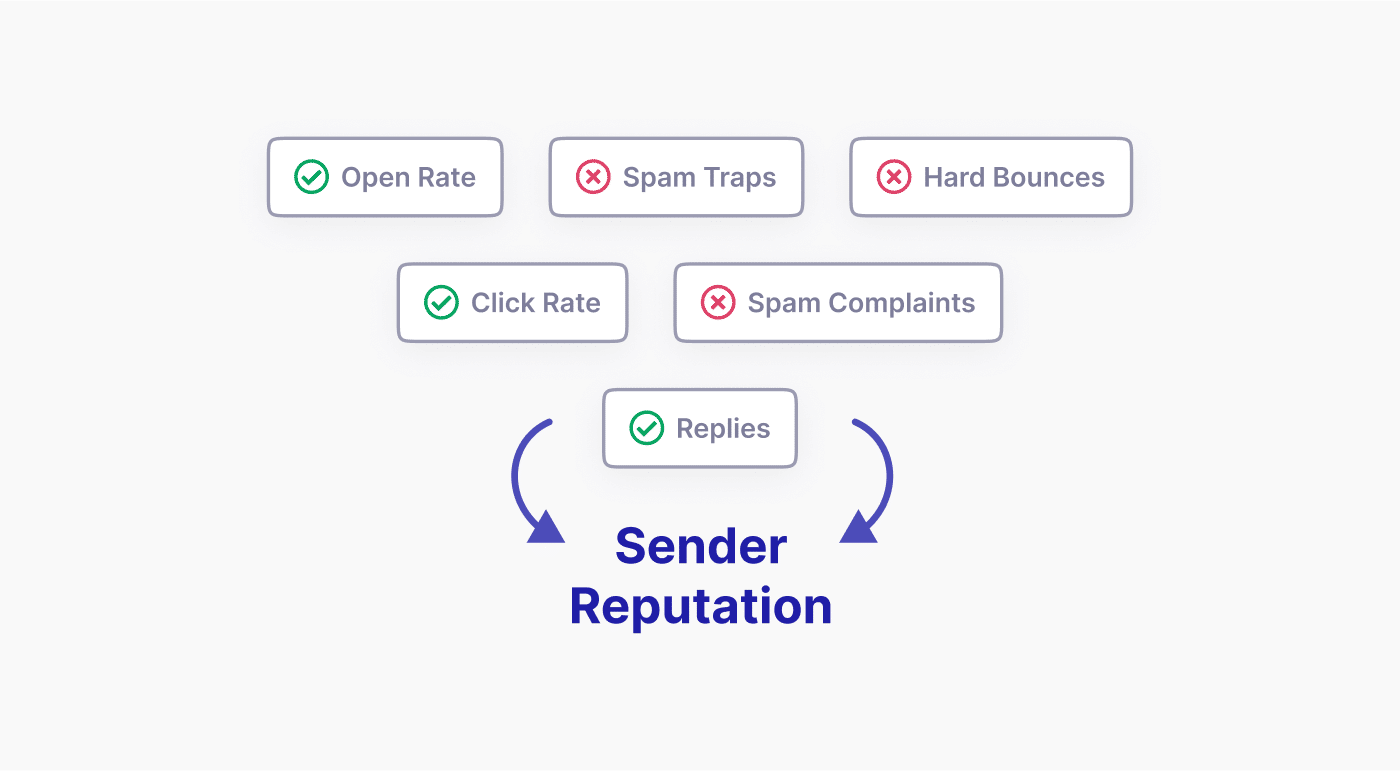
When you hit or exceed spam rate thresholds, your reputation score can take a hit. This lower score can then lead to more delivery problems, creating a cycle that’s hard to break.
Going over spam thresholds also puts you at risk of being blacklisted. This is a serious consequence that can severely impact your email marketing efforts. When you’re on a blacklist, many email services will automatically block all emails from your domain or IP address.
The process of fixing a damaged sender reputation or getting removed from a blacklist isn’t quick or easy. It often takes months of consistent, positive email practices to see improvements.
Generally, it takes about 3-4 weeks of good behavior just to start seeing the beginnings of reputation repair. During this time, your email performance will likely suffer.
It’s not just your technical reputation that’s at stake, either. High spam rates can harm your overall brand reputation too.
When customers frequently see your emails in their spam folders, or don’t receive your emails at all, they may start to view your company as untrustworthy or unprofessional.
How to Stay Below Spam Rate Thresholds
So how can you ensure your emails stay on the right side of these thresholds? I covered this in detail in this guide on how to reduce email spam complaints so make sure to head over there for full understanding. But if you just want the overview, there are a few tried and true tactics to keep those spam complaints to a minimum:
- Practice good list hygiene: Regularly remove inactive subscribers, use double opt-in to ensure subscribers really want your emails, and make it easy to unsubscribe
- Create valuable and relevant content: The key to low spam rates is sending emails people actually want to receive. Aim to provide value in every email and consider segmenting your list and using personalization to send more relevant content.
- Authenticate your emails: Set up SPF, DKIM, and DMARC authentication to help ESPs know your emails are genuine
- Monitor your metrics: You can’t know what you don’t measure, so keep an eye on your numbers in spam rate checker tools like Google Postmaster Tools and take action quickly if you get close to threshold limits
What to Do If You Exceed Spam Rate Thresholds
Despite your best efforts, you might find yourself exceeding spam rate thresholds. Don’t panic! Here’s what to do:
- Pause and Assess: Stop sending immediately and take a close look at your recent email campaigns. What changed? Did you send to a new segment? Did you change your content strategy?
- Clean Your List: Remove any email addresses that bounced or complained. Consider removing inactive subscribers as well.
- Review Your Content: Look for any elements that might be triggering spam filters. This could be certain words, too many images, or misleading subject lines.
Check Your Authentication: Ensure all your authentication methods (SPF, DKIM, DMARC) are set up correctly. - Engage Your Engaged Users: In most cases, a high spam complaint is a temporary blip. But if you’re hitting thresholds regularly, consider sending emails only to your most engaged subscribers. This will help rebuild your sender reputation and improve email deliverability.
- Learn and Adapt: Use this as a learning experience. What can you do differently moving forward to prevent exceeding thresholds again?
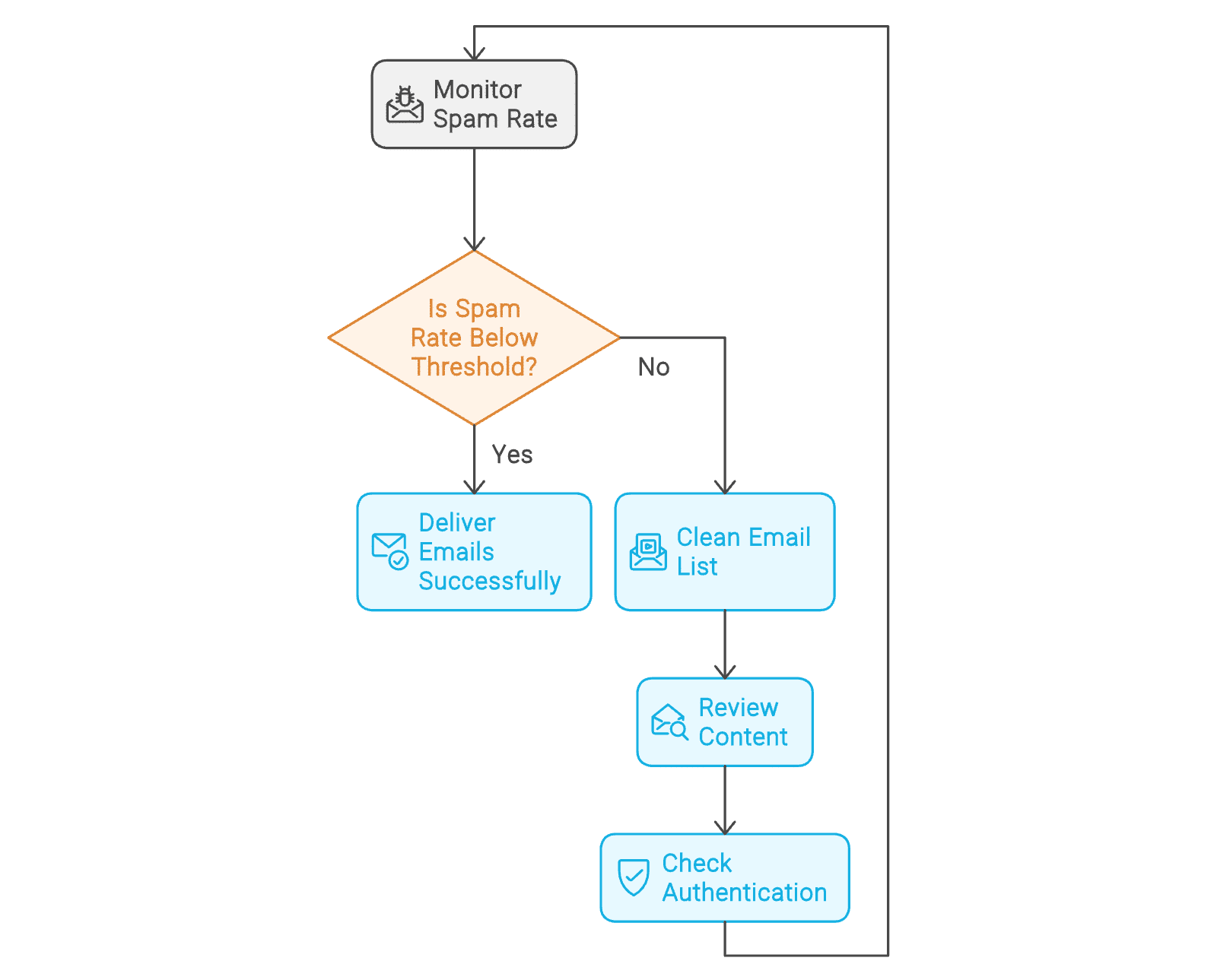
Remember, recovering from exceeding spam rate thresholds is a process. It won’t happen overnight, but with patience and the right strategy, you can get back on track.
Next, Learn About Email Compliance
Keeping spam complaints low is just one small part of what it takes to make your email marketing strategy a success.
It’s also crucial to stay on the right side of the law and make sure you’re following guidelines to stay compliant with CAN-SPAM, GDPR, and other email regulations. Read our guide to email compliance to find out more.
Ready to fix your emails? Get started today with the best WordPress SMTP plugin. If you don’t have the time to fix your emails, you can get full White Glove Setup assistance as an extra purchase, and there’s a 14-day money-back guarantee for all paid plans.
